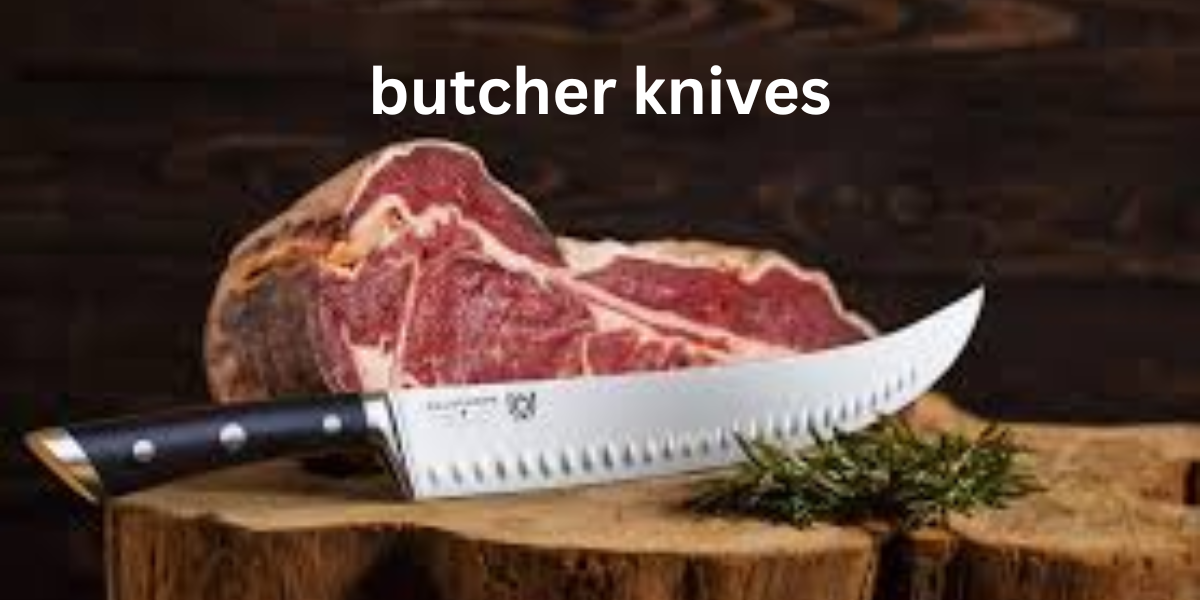Butcher Knives: The Essential Tool for Meat Preparation
When it comes to preparing meat, few tools are as essential as a butcher knife. Whether you’re a professional butcher or a home cook, having the right knife can make all the difference in efficiency, precision, and safety. Butcher knives are designed specifically to handle the tough, heavy-duty tasks of cutting through bone, cartilage, and tough cuts of meat. In this article, we’ll explore the various types of butcher knives, their uses, and tips on choosing the right one for your needs.
The Importance of Butcher Knives
Butcher knives are built to withstand the demands of cutting and preparing meat, unlike regular kitchen knives. They are heavy, strong, and durable, providing the necessary leverage and power to cut through tough materials. Using a proper butcher knife ensures more accurate cuts, faster processing, and less risk of injury, as these knives are specifically crafted for the demands of meat work.

Types of Butcher Knives
Butcher knives come in a variety of shapes and sizes, each tailored to specific tasks. Some of the most common types include:
- The Butcher’s Knife (Boning Knife)
This is the classic knife that most people think of when they hear “butcher knife.” It typically features a long, wide blade with a sharp, pointed edge. It’s used to slice through large cuts of meat, trim fat, and remove bones. The blade is usually curved, which makes it easier to follow the contours of bones and joints. - Cleaver
Cleavers are large, heavy knives with a broad, rectangular blade. They’re designed to chop through bones and tough materials with minimal effort. Cleavers are also great for cutting through large slabs of meat, and their heft provides the force needed to break through bone with a single strike. Cleavers are commonly used in both commercial butcher shops and home kitchens for heavy-duty work. - Slicing Knife
A slicing knife is long and thin with a slightly flexible blade, perfect for slicing cooked or raw meat into even, thin pieces. While not exclusively a “butcher knife,” it’s often used in conjunction with other knives for precision cuts and to create uniform slices of roast or fish. - Breaking Knife
A breaking knife is a large knife used primarily for breaking down large carcasses. It has a long, broad blade that’s slightly flexible, allowing it to cut through large sections of meat with ease. This type of knife is essential for those who regularly work with whole animals and need to break them down into smaller, more manageable pieces. - Trimming Knife
This smaller knife is ideal for removing fat and skin from meat. Its blade is sharp and narrow, offering greater control when working on delicate areas that require a more precise cut.
Materials Used in Butcher Knives
The quality of a butcher knife largely depends on the material of the blade. Most butcher knives are made from either stainless steel, carbon steel, or a combination of the two:
- Stainless Steel: Known for its corrosion resistance and easy maintenance, stainless steel is a popular choice for butcher knives. While it may not be as sharp as carbon steel, it holds an edge well and is easier to maintain.
- Carbon Steel: These knives are known for their superior sharpness and ability to hold an edge longer. However, they require more care to prevent rusting, as carbon steel is more prone to corrosion than stainless steel.
- High Carbon Stainless Steel: This is a hybrid material that combines the benefits of both stainless and carbon steel, offering a balance between sharpness, edge retention, and rust resistance.
How to Choose the Right Butcher Knife
Choosing the right butcher knife depends on your specific needs. Here are a few factors to consider:
- Task: Think about the type of meat you will be preparing. If you mostly work with poultry, a boning knife may be sufficient. If you’re working with larger cuts or whole carcasses, a cleaver or breaking knife would be more suitable.
- Handle: The handle of the knife should feel comfortable and secure in your hand. Look for ergonomically designed handles made from materials like wood, plastic, or rubber. The handle should provide a firm grip to ensure safety during use.
- Blade Length: Longer blades provide more cutting surface and are useful for larger cuts, while shorter blades offer more control for smaller, more detailed tasks.
- Maintenance: Some knives require more maintenance than others, especially carbon steel knives that need to be oiled to prevent rust. Consider how much care you’re willing to put into maintaining your knives.
Proper Use and Care of Butcher Knives
To ensure your butcher knives last a long time and continue to perform well, proper care is essential. Here are some tips:
- Sharpen Regularly: A sharp knife is both safer and more efficient. Regularly sharpen your butcher knife using a honing steel or a sharpening stone. A dull knife can slip and cause accidents.
- Clean After Each Use: After each use, wash your knife with warm, soapy water and dry it immediately. Avoid leaving it in the sink or soaking it, as this can cause rust.
- Store Properly: Store your knives in a safe, dry place. A knife block, magnetic strip, or a protective sheath will help maintain the blade’s integrity.
- Use a Cutting Board: Always use a cutting board to avoid damaging the blade. Avoid cutting on hard surfaces like glass, metal, or stone, as this can dull the edge quickly.
Conclusion
Butcher knives are essential tools for anyone working with meat, from professional butchers to home chefs. Understanding the different types of butcher knives and their specific uses will help you choose the right tool for your meat preparation needs. Whether you’re breaking down large cuts, trimming fat, or slicing meat, having the right knife will not only make the job easier but also safer and more precise. With the proper care and maintenance, a good butcher knife can serve you for years, ensuring that you always have the right tool for the job.
Frequently Asked Questions (FAQs) About Butcher Knives
1. What is the difference between a butcher knife and a regular kitchen knife?
A butcher knife is designed specifically for handling tough cuts of meat, including slicing through bone and cartilage, which requires a stronger, heavier, and more durable blade. Regular kitchen knives are typically lighter and more versatile for general food prep but aren’t built to withstand the rigorous demands of meat processing.
2. How do I choose the right butcher knife for my needs?
To choose the right butcher knife, consider the types of meat you work with most frequently. For example:
- If you break down whole animals, a breaking knife or cleaver is ideal.
- If you need precision for trimming or deboning, a boning knife or trimming knife would be better.
- For slicing, a slicing knife with a longer, flexible blade is appropriate.
Consider your comfort with the handle design and the length of the blade to ensure proper control and ease of use.
3. What is a cleaver used for?
A cleaver is a large, heavy knife used for chopping through bone and dense materials. Its broad, rectangular blade can easily cut through tough sections of meat and bone. It’s often used for breaking down larger cuts of meat or for more aggressive chopping tasks.
4. Can I use a butcher knife for vegetables?
While butcher knives are designed primarily for meat, you can use them for cutting vegetables, especially hard ones like squash or pumpkins. However, using them on softer vegetables might damage the blade or be less efficient compared to a specialized vegetable knife.
5. How should I maintain my butcher knife?
- Sharpen regularly: Keep your knife sharp using a honing steel, sharpening stone, or a professional sharpening service.
- Clean properly: Wash the knife immediately after use with warm, soapy water, and dry it thoroughly to prevent rust.
- Store safely: Store your butcher knife in a knife block, on a magnetic strip, or with a protective sheath to avoid damage.
- Avoid soaking: Never leave your knife in the sink, as prolonged exposure to water can cause corrosion, especially for carbon steel knives.
6. What material is best for a butcher knife blade?
The best material depends on your preferences:
- Stainless steel is corrosion-resistant, easy to maintain, and durable.
- Carbon steel is sharper and holds an edge longer but requires more care to avoid rust.
- High-carbon stainless steel offers a combination of both, providing good sharpness and rust resistance with relatively easy maintenance.
7. Are expensive butcher knives worth the investment?
Higher-quality knives tend to be sharper, more durable, and hold their edge longer, making them a good investment for serious cooks or professional butchers. However, a good mid-range knife can still offer excellent performance if you’re on a budget. It’s essential to find a knife that fits your needs, preferences, and maintenance commitment.
8. Can I use a butcher knife to cut frozen meat?
While it’s possible to use a butcher knife on frozen meat, it’s not recommended because it could damage the blade. If you need to cut frozen meat, it’s better to use a meat saw or wait until the meat has thawed enough to make cutting easier and safer.
9. Why is a boning knife different from a butcher knife?
A boning knife is thinner, more flexible, and narrower than a typical butcher knife. It’s designed for the delicate task of removing bones from meat, providing greater control and precision. A butcher knife, on the other hand, is often heavier and broader, ideal for tasks like chopping, slicing large cuts of meat, or breaking down carcasses.
10. How do I know when my butcher knife needs sharpening?
You’ll know it’s time to sharpen your knife when it starts feeling dull. If the knife struggles to cut through meat or slips off bones, it’s losing its sharp edge. You can also perform the “paper test”—try cutting through a piece of paper. If the knife struggles or tears the paper unevenly, it’s time to sharpen it.







